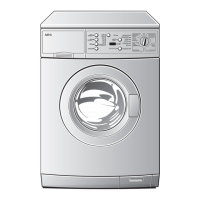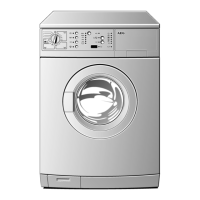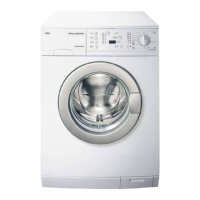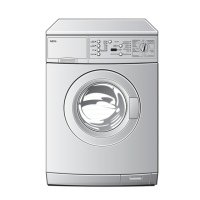Do you have a question about the AEG LAVAMAT 72950A3 and is the answer not in the manual?
General safety guidelines for operating the washing machine, including precautions against altering specifications or touching hot parts.
Instructions and precautions for installing the washing machine, including unpacking and connection checks.
Guidelines for using the washing machine for domestic purposes, including fabric types and loading.
Safety measures to prevent children from accessing or playing with the washing machine.
Description of the detergent dispenser drawer compartments for pre-wash, main wash, and additives.
Steps for initial setup and first use of the washing machine, including connection checks.
Information on personalizing the appliance, including acoustic signals and child safety lock.
Step-by-step guide on how to correctly load laundry into the washing machine drum.
Instructions on how to add detergent and fabric softener to the correct compartments in the dispenser drawer.
Guide on how to select a washing programme using the main selector dial and its functions.
How to adjust the wash temperature using the dedicated button, including cold wash indication.
How to select spin speed, NIGHT CYCLE or RINSE HOLD options using button 3.
Explanation of how to select and combine various programme options using buttons 4 and 5.
Details on selecting the PREWASH option for heavily soiled laundry, including its effect on different fabric types.
Information on using the STAIN option for heavily soiled or stained laundry, including temperature limitations.
How to select the SENSITIVE option to reduce washing intensity and add an extra rinse.
Explanation of the EXTRA RINSE option for users with sensitive skin or to remove detergent residue.
How to use the TIME SAVING button to select DAILY or SUPER QUICK washing modes.
Instructions on how to start, pause, and resume a washing programme using the START/PAUSE button.
Guide on setting a delayed start for the washing programme, including time adjustments and cancellation.
How to change options or programmes during a cycle, including pausing and resetting.
Method to cancel a running programme by turning the selector dial.
Programme for cotton and white/coloured items, 95°-Cold, with long spin at maximum speed.
Programme for white cottons at 60°C with an additional rinse for hygiene and micro-organism elimination.
Mixed programme for white and coloured cottons at 40°C or 60°C, designed for energy and water saving.
Programme for heavy fabrics like jeans and jersey at 60°-Cold, with long spin at 1200 rpm.
Programme for synthetic or mixed fabrics, 60°-Cold, with short spin at 1200 rpm.
Programme for easy ironing, 60°-Cold, with short spin at 1200 rpm, for gentle washing and spinning.
Programme for delicate fabrics like acrylics, viscose, polyester at 40°-Cold, with short spin at 1200 rpm.
Special gentle programme for fabrics like viscose, cupro, lyocell at 40°-Cold, with short spin.
Programme for rinsing and spinning hand-washed cotton garments, with short spin at 1200 rpm.
Programme for draining water from the last rinse, with a maximum load of 8 kg.
Programme for draining and spinning hand-washed cotton garments or after cycles ending with water in the tub.
Special programme for synthetic blankets, duvets, bedspreads at 40°-30°, with short spin at 800 rpm.
Programme for machine washable wool or hand washable woollens at 40°-Cold, with short spin at 1200 rpm.
Programme for very delicate items like lingerie, bras, underwear at 40°-Cold, with short spin at 1200 rpm.
Special programme for sport clothes at 40°-Cold, with short spin at 800 rpm.
Programme for heavily soiled sport items, including prewash, at 40°-Cold, with short spin at 1200 rpm.
Quick washing programme for lightly soiled items at 30°, with short spin at 1200 rpm.
Quick washing programme for lightly soiled white/coloured cottons and mixed fabrics at 60°-40°, with short spin at 1200 rpm.
Cold wash programme for mixed fabrics, designed for energy, water, and time saving.
Guidance on sorting laundry by colour and fabric type according to wash code symbols.
Recommended washing temperatures for different types of laundry and soiling levels.
Tips for preparing laundry before washing, including checking pockets, fastening zips, and treating stains.
General rules and recommendations for maximum laundry load capacity based on fabric type.
Indicative weights for common laundry items to help estimate load size.
Detailed advice on how to treat and remove various common stubborn stains using specific methods.
Specific instructions for removing ink and tar stains from fabrics using various cleaning agents.
Guidance on selecting and using detergents and additives, including types and quantities.
Explanation of water hardness levels and their impact on detergent usage, with a table of hardness classifications.
Recommendation to periodically use a water softening powder to prevent lime deposits.
Advice to leave the door open after each wash to prevent mould and preserve the door seal.
Recommendation for performing a maintenance wash regularly to remove residues from the drum.
Instructions for cleaning the exterior cabinet of the appliance with soap and water.
Step-by-step guide on how to remove and clean the detergent dispenser drawer and its components.
Instructions on how to remove rust deposits from the washing drum using a specific cleaning agent.
Advice to check the door seal and trapped objects periodically.
Guidance on inspecting the drain pump, especially if issues with emptying or unusual noises occur.
Steps for using the emergency emptying hose to drain water from the machine.
Detailed instructions on how to remove, clean, and replace the pump filter.
Steps to take to protect the machine from frost damage when installed in cold environments.
Detailed procedure for manually emptying the machine if the water is not discharged.
Troubleshooting steps for when the washing machine fails to start, including checking door, plug, and settings.
Troubleshooting steps for when the machine does not fill with water, checking tap, hose, and filters.
Troubleshooting for immediate draining, usually related to drain hose height or kinks.
Troubleshooting steps for issues with emptying or spinning, checking drain hose, filter, and load distribution.
Troubleshooting steps for water leaks, checking hose connections, damage, and filter sealing.
Tips for improving washing results, checking detergent, temperature, and load size.
Troubleshooting steps for when the door remains locked after the cycle, checking programme status and water level.
Troubleshooting steps for vibration and noise issues, checking transit bolts, levelling, and load distribution.
Troubleshooting for delayed or absent spinning, related to unbalance detection or insufficient load.
Explanation of unusual noises from the motor, which may be normal for the new technology.
Explanation for no visible water, related to economical operation using less water.
Action to take when the EFO alarm code appears, indicating anti-flooding system activation.
Instructions for removing transit bolts and packaging, and preparing the machine for installation.
Information about the water-stop device in the inlet hose and how to identify/handle faults.
Description of the three methods for positioning the drain hose for proper water drainage.
Information on the recyclability of packaging materials used for the appliance.
Recommendations for saving water, energy, and protecting the environment during laundry washing.
General safety guidelines for operating the washing machine, including precautions against altering specifications or touching hot parts.
Instructions and precautions for installing the washing machine, including unpacking and connection checks.
Guidelines for using the washing machine for domestic purposes, including fabric types and loading.
Safety measures to prevent children from accessing or playing with the washing machine.
Description of the detergent dispenser drawer compartments for pre-wash, main wash, and additives.
Steps for initial setup and first use of the washing machine, including connection checks.
Information on personalizing the appliance, including acoustic signals and child safety lock.
Step-by-step guide on how to correctly load laundry into the washing machine drum.
Instructions on how to add detergent and fabric softener to the correct compartments in the dispenser drawer.
Guide on how to select a washing programme using the main selector dial and its functions.
How to adjust the wash temperature using the dedicated button, including cold wash indication.
How to select spin speed, NIGHT CYCLE or RINSE HOLD options using button 3.
Explanation of how to select and combine various programme options using buttons 4 and 5.
Details on selecting the PREWASH option for heavily soiled laundry, including its effect on different fabric types.
Information on using the STAIN option for heavily soiled or stained laundry, including temperature limitations.
How to select the SENSITIVE option to reduce washing intensity and add an extra rinse.
Explanation of the EXTRA RINSE option for users with sensitive skin or to remove detergent residue.
How to use the TIME SAVING button to select DAILY or SUPER QUICK washing modes.
Instructions on how to start, pause, and resume a washing programme using the START/PAUSE button.
Guide on setting a delayed start for the washing programme, including time adjustments and cancellation.
How to change options or programmes during a cycle, including pausing and resetting.
Method to cancel a running programme by turning the selector dial.
Programme for cotton and white/coloured items, 95°-Cold, with long spin at maximum speed.
Programme for white cottons at 60°C with an additional rinse for hygiene and micro-organism elimination.
Mixed programme for white and coloured cottons at 40°C or 60°C, designed for energy and water saving.
Programme for heavy fabrics like jeans and jersey at 60°-Cold, with long spin at 1200 rpm.
Programme for synthetic or mixed fabrics, 60°-Cold, with short spin at 1200 rpm.
Programme for easy ironing, 60°-Cold, with short spin at 1200 rpm, for gentle washing and spinning.
Programme for delicate fabrics like acrylics, viscose, polyester at 40°-Cold, with short spin at 1200 rpm.
Special gentle programme for fabrics like viscose, cupro, lyocell at 40°-Cold, with short spin.
Programme for rinsing and spinning hand-washed cotton garments, with short spin at 1200 rpm.
Programme for draining water from the last rinse, with a maximum load of 8 kg.
Programme for draining and spinning hand-washed cotton garments or after cycles ending with water in the tub.
Special programme for synthetic blankets, duvets, bedspreads at 40°-30°, with short spin at 800 rpm.
Programme for machine washable wool or hand washable woollens at 40°-Cold, with short spin at 1200 rpm.
Programme for very delicate items like lingerie, bras, underwear at 40°-Cold, with short spin at 1200 rpm.
Special programme for sport clothes at 40°-Cold, with short spin at 800 rpm.
Programme for heavily soiled sport items, including prewash, at 40°-Cold, with short spin at 1200 rpm.
Quick washing programme for lightly soiled items at 30°, with short spin at 1200 rpm.
Quick washing programme for lightly soiled white/coloured cottons and mixed fabrics at 60°-40°, with short spin at 1200 rpm.
Cold wash programme for mixed fabrics, designed for energy, water, and time saving.
Guidance on sorting laundry by colour and fabric type according to wash code symbols.
Recommended washing temperatures for different types of laundry and soiling levels.
Tips for preparing laundry before washing, including checking pockets, fastening zips, and treating stains.
General rules and recommendations for maximum laundry load capacity based on fabric type.
Indicative weights for common laundry items to help estimate load size.
Detailed advice on how to treat and remove various common stubborn stains using specific methods.
Specific instructions for removing ink and tar stains from fabrics using various cleaning agents.
Guidance on selecting and using detergents and additives, including types and quantities.
Explanation of water hardness levels and their impact on detergent usage, with a table of hardness classifications.
Recommendation to periodically use a water softening powder to prevent lime deposits.
Advice to leave the door open after each wash to prevent mould and preserve the door seal.
Recommendation for performing a maintenance wash regularly to remove residues from the drum.
Instructions for cleaning the exterior cabinet of the appliance with soap and water.
Step-by-step guide on how to remove and clean the detergent dispenser drawer and its components.
Instructions on how to remove rust deposits from the washing drum using a specific cleaning agent.
Advice to check the door seal and trapped objects periodically.
Guidance on inspecting the drain pump, especially if issues with emptying or unusual noises occur.
Steps for using the emergency emptying hose to drain water from the machine.
Detailed instructions on how to remove, clean, and replace the pump filter.
Steps to take to protect the machine from frost damage when installed in cold environments.
Detailed procedure for manually emptying the machine if the water is not discharged.
Troubleshooting steps for when the washing machine fails to start, including checking door, plug, and settings.
Troubleshooting steps for when the machine does not fill with water, checking tap, hose, and filters.
Troubleshooting for immediate draining, usually related to drain hose height or kinks.
Troubleshooting steps for issues with emptying or spinning, checking drain hose, filter, and load distribution.
Troubleshooting steps for water leaks, checking hose connections, damage, and filter sealing.
Tips for improving washing results, checking detergent, temperature, and load size.
Troubleshooting steps for when the door remains locked after the cycle, checking programme status and water level.
Troubleshooting steps for vibration and noise issues, checking transit bolts, levelling, and load distribution.
Troubleshooting for delayed or absent spinning, related to unbalance detection or insufficient load.
Explanation of unusual noises from the motor, which may be normal for the new technology.
Explanation for no visible water, related to economical operation using less water.
Action to take when the EFO alarm code appears, indicating anti-flooding system activation.
Instructions for removing transit bolts and packaging, and preparing the machine for installation.
Information about the water-stop device in the inlet hose and how to identify/handle faults.
Description of the three methods for positioning the drain hose for proper water drainage.
Information on the recyclability of packaging materials used for the appliance.
Recommendations for saving water, energy, and protecting the environment during laundry washing.
| Capacity | 9 kg |
|---|---|
| Energy Efficiency Class | A+++ |
| Dimensions (HxWxD) | 850 x 600 x 600 mm |
| Weight | 81.5 kg |
| Color | White |
| Loading type | Front |
| Washing capacity | 9 kg |
| Type | Front-loading washer |











